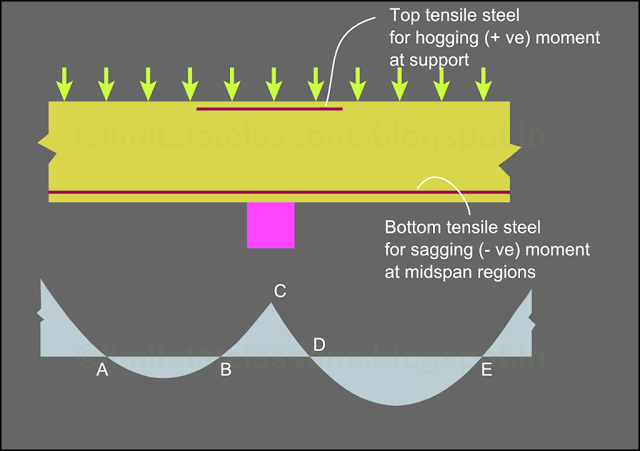In the previous section we saw one method to give the required anchorage at the end of stirrups. Now we will see the other methods.
Method 2: Using 180o bend
In this, we use a type of bending similar to the standard U-type hook that we discussed earlier. As before, the hook is given at both the ends of the bar of the stirrup. This is shown in the fig.14.19 below:
Fig.14.19
Anchorage of stirrups: Method 2
Here, the extension DE beyond the bent portion is the same 4φ that we saw earlier in the case of the ‘standard U-type hook’. [Note that, in the Method 1, where we used standard 90o bend at the ends of stirrups, the length of DE was 8φ.] The resulting final shape of the stirrup is shown in fig.14.20 below.
Fig.14.20
Resulting shape of stirrup
Method 3: Using 135o bend
In this case we use a type of bending that we have not discussed before. We know that the ‘standard 90o bend’ has an angle of 90o, and a ‘standard U-type hook’ has an angle of 180o. The new type which we are going to see has an angle which is the average of these two values. That is : (90 + 180) / 2 = 135o. This is shown in the fig.14.21 below:
Fig.14.21
135o bend in a bar
Here angle DOB = 135o. So the portion BCD is the exact 3/8 of a ring (∵ 135/360 = 3/8) having inner radius r. As usual, we must extend it beyond D. Here, for the purpose of anchoring stirrup ends, this extension required is equal to 6φ . Note that 6φ is the average of 8φ (Method 1) and 4φ (Method 2). Fig.14.22 shows the extension.
Fig.14.22
135o bend for anchoring the stirrup
Note that angle EDO is 90o. We will apply this bend to the two ends of the stirrup bar as shown below:
Fig.14.23
Anchorage of stirrups: Method 3
The resulting final shape of the stirrup is shown in fig.14.24 below:
Fig.14.24
Resulting shape of stirrup
This completes the discussion about the anchorage to be provided to the stirrups. A few important additional points are given below:
The grip is exerted by the concrete mainly on the straight portion DE coming after the bend, at the ends of the stirrup bar. In the previous section we saw the method of anchorage for stirrups by 90o bend (Method 1). We discussed it based on fig.14.17. In this method, the straight portion is nearer to the outer surface of a concrete member. (In methods 2 and 3, DE is embedded into the mass of concrete of the beam). So, if the defect known as ‘spalling’ occurs in the concrete member, the outer cover for DE may fall off. (More details about spalling can be seen here) This will reduce the anchorage provided to the ends of the stirrup. In such a situation, if the stirrup bars undergo higher tensions, it may open out due to the non availability of concrete to keep the ends in position. So we must adopt Method 2 or Method 3 in situations where concrete cover around the stirrups is not restrained against spalling.
The next point that we have to note, is the radius of the bends at the four corners of the stirrups. In the figs. 14.17, 14.19, and 14.23, that we saw for the three methods of anchorage, the diameter of the bar of the stirrup is about 10 mm. We have seen that, the radius of the bend should not be less than 4 times the diameter. So a radius of 40 mm is given. Then the diameter of the bend will be 80 mm. This means that the bar shown in blue colour at the corner of the stirrup has a diameter of 80 mm. But bar diameters greater than 36 mm are not generally used in practice. And it is not practical to give such large diameter bends at each corner of a beam.
The main reason for specifying a large radius for the bend is to reduce the 'bearing stress' on concrete. But in a beam, there will be a longitudinal bar at each corner of the stirrup. So, even if the radius is small, the concrete will not be subjected to much bearing stress at the corners. We will learn more details about bearing stress in a later section.
We used a large value of bending radius in the figs. of stirrups, just for the clarity of showing the bending procedure, and for showing the similarity with the standard bends. Fig.14.25 below shows the correct procedure. A 10 mm dia. bar is given a 135o bend around a normal diameter bar. The larger radius bend is also shown along side for comparison. In the fig., the dia. of the bar of stirrup is the same in both the cases.
Comparison between small and large radius of bend
In the above fig.,
• The stirrup bar AE has the same diameter in both the cases.
• The length of the extension DE is the same in both the cases.
• Angle BOD is equal to 135o in both the cases.
• BCD in both the cases are exact 3/8 of their corresponding rings.
• The only difference is that, the radius of the ring on the left side is small, and that on the right side is large.
In the above fig., (a) shows a stirrup with both ends bent through 90o, (b) shows 180o and (c) shows 135o.
In the next section, we will discuss about the 'bearing stress' caused in concrete by the forces in the bends.
Copyright©2015 limitstatelessons.blogspot.com - All Rights Reserved




























